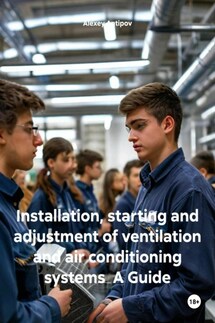Installation, starting and adjustment of ventilation and air conditioning systems A Guide - страница 4
Questions for chapter 2
1. Name the main parameters of the air environment.
2. What is the main purpose of the ventilation system?
3. In which cases the use of natural ventilation systems is justified.
4. What is the advantage of mechanical ventilation systems?
5. What is the name of the process of heat recovery of the removed air, what are its technical and economic advantages?
6. What material is used to produce ventilation ducts most often?
7. What, in your opinion, is affected by the thickness of the metal in the production of air ducts?
8. In which cases air showering is used?
9. Name the main processes of air treatment in the supply ventilation system.
10. In which cases a special design of air ducts and ventilation equipment is used?
Chapter III. Equipment of air ventilation systems
As indicated above, the required state of the air environment in the premises is maintained by general exchange ventilation methods by pumping clean ventilation air into the premises with the necessary temperature-humidity parameters and removal of air that does not meet regulatory requirements. In accordance with this, general exchange ventilation systems should include equipment and devices for intake of outdoor air, its processing, transportation and distribution around the premises, as well as for the removal of exhaust air.
3.1. Air intake and air discharge devices
These include air intake and air discharge devices in mechanical ventilation systems, which are made in the form of holes in the fences of buildings, attached or freestanding shafts. When air is taken from above, the air intake devices are placed in the attic or upper floor of the building, and the channels are removed above the roof in the form of shafts.
For aeration, air intake and ejection devices are made in the form of rotating transoms, opening lanterns, windows or other overlapping apertures in the fences of buildings.
The location and design of the air intake devices are selected taking into account the cleanliness of the intake air and the satisfaction of architectural requirements. Thus, air intake devices should not be located near sources of air pollution (emissions of polluted air or gases, chimneys, kitchens, unpaved roads, etc.).
Air intake apertures should be located at a height of at least 2 m from the ground surface and closed with louvered grilles (in the green zone – at a height of at least 1 m).
To protect the premises from outside cold air during standby of the ventilation through ventilation ducts, air intake and air discharge devices are equipped with multi-leaf insulated valves with manual or mechanical drive. In the latter case, the valve is blocked along with the fan closing the apertures. At low temperature of the outside air, the valves are supplied with an electric heating system in order to protect their flaps from freezing. Electric heating is turned on for 10–15 minutes before starting the fan (Fig.2).
Fig.2. Electric air valve
The outer walls of exhaust ducts and shafts are insulated to avoid condensation and ice of water vapor from the extracted moist air. The air velocity in the supply channels and shafts is supported between 2 and 5 m/s, in the channels and shafts of exhaust devices: 4–8 m/s, but not less than 0.5 m/s, including for natural ventilation.
3.2. Ventilation chambers






